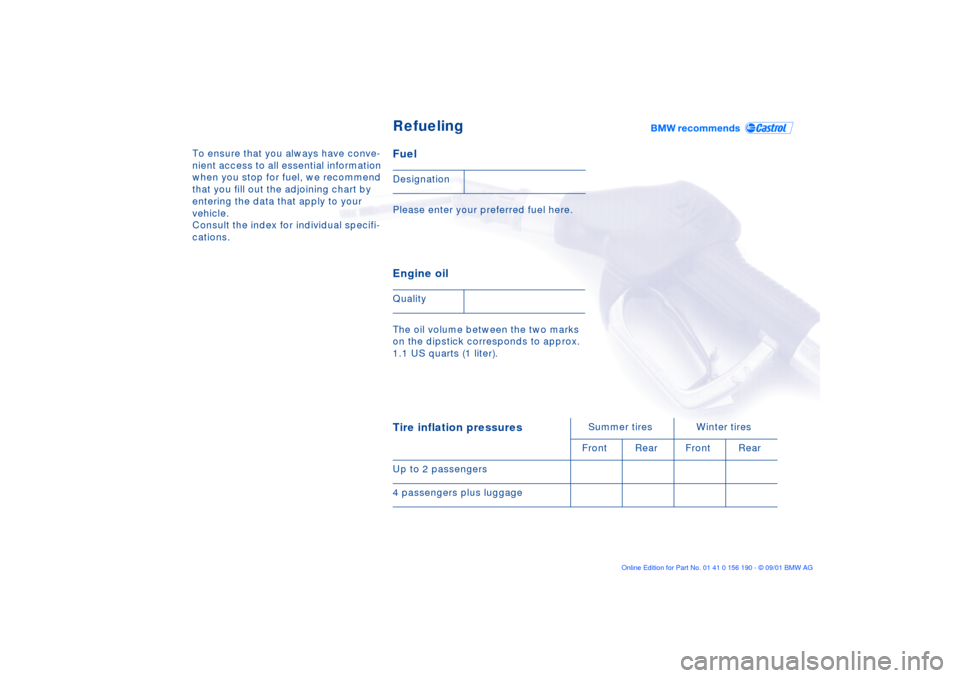2002 BMW 330Ci CONVERTIBLE flat tire
[x] Cancel search: flat tirePage 137 of 159

137n
OverviewControlsMaintenanceRepairsDataIndex
Changing a wheel8. Remove accumulations of mud and
dirt from the mounting surfaces of
the wheel and hub. Clean the lug
bolts
9. Position the new wheel or the
space saver spare tire on the hub
and screw at least two lug bolts
finger-tight into opposite bolt holes
10. Screw in the remaining lug bolts
and screw in all the bolts in a diag-
onal pattern
11. Lower the jack and remove it from
beneath the vehicle
12. Tighten the lug bolts securely in a
diagonal pattern
13. Wheels with full wheel covers
*:
Place the wheel cover with the
valve opening (arrow) over the
valve. Use both hands to press the
cover securely onto the rim
14. Check and correct the tire inflation
pressure at the earliest opportunity.
Vehicles with Tire Pressure Monitor
(RDC)/Flat Tire Monitor:
After mounting the spare tire or
correcting the tire inflation pres-
sure, reactivate the system, refer to
page 83 or 85.
Protect valve stems and valves from dirt
using screw-on valve stem caps. Dirty
valve stems frequently lead to slow
pressure loss.
Only use original BMW full wheel
covers, otherwise, the trim piece
may not fit securely. The full wheel
cover may not be installed on the
space-saver spare tire, since this could
damage the cover.<
The vehicle jack is designed for
changing wheels only. Do not
attempt to raise another vehicle model
with it or to raise any load of any kind.
To do so could cause accidents and
personal injury.
To ensure continued safety, have the
tightness of the lug bolts checked with
a calibrated lug wrench [torque specifi-
cation: 72 lb ft (72 100 Nm] at the
earliest opportunity.<
When storing a wheel in the spare tire
recess take care to avoid bending the
threaded rod.
If light-alloy wheels other than original
BMW light-alloy wheels have been
mounted, it may be necessary to use
different lug bolts for those wheels.
Replace the defective tire as soon as
possible and have the new wheel/tire
balanced.
Page 138 of 159

138n
Changing a wheelDriving with the space-saver
spare tireDrive cautiously. Do not exceed a
speed of 50 mph (80 km/h).
You can anticipate changes in vehicle
handling such as delayed braking
response, longer braking distances and
sacrifices in roadholding.
The changes in handling characteristics
will be even more pronounced in
conjunction with winter tires.
Only one space-saver spare tire
may be mounted at one time.
Reinstall wheels and tires of the same
size and specification as soon as
possible. Maintain correct tire pres-
sures, refer to page 25.<
Safety tires
*
Safety tires consist of self-supporting
tires and special rims. The tire rein-
forcement ensures that the tire retains
some residual safety in the event of
pressure drop and driving remains
possible to a restricted degree. The
vehicle is equipped with Tire Pressure
Monitor (RDC) or Flat Tire Monitor,
which indicate a flat tire.Flat tireIf there is a tire failure, the red warning
lamp symbol lights up. A supplemen-
tary gong is also heard.
For additional information on Tire Pres-
sure Monitor (RDC) or Flat Tire Monitor
refer to page 83 or 85.
Reduce vehicle speed carefully to
under 50 mph (80 km/h), avoiding hard
brake applications and steering maneu-
vers.
With the safety tires, you can drive
another approx. 155 miles (250 km) to
reach a safe parking location, a service
station or the nearest BMW center.
With a low vehicle load, this can also be
considerably more than 155 miles
(250 km).Safety tires are only possible in
conjunction with Tire Pressure
Monitor (RDC) or Flat Tire Monitor.<
If the defective wheel cannot be seen
as such immediately from the outside,
check the tire inflation pressure at all
four wheels.
Have the tires changed by your
BMW center. For safety reasons,
do not have a safety tire repaired. Your
BMW center has the information
needed for working with safety tires
and is equipped with the necessary
special tools.<
If appropriate, please consult your
BMW center to reequip your
vehicle from summer to winter tires Ð or
vice versa.<
Page 152 of 159

Everything from A to ZDisplay lighting88
Displays15
Disposal
antifreeze and anti-
corrosion agents123
battery139
brake fluid124
engine oil122
Distance warning79
Door keys28
Doors
electrical malfunction31
locking and unlocking29
manual operation31
DOT Quality Grades,
tires114
Draft-free ventilation92, 95
Drive belts17
Driving notes109
DSC (Dynamic Stability
Control)81
DSC Dynamic Stability
Control19, 81
Dynamic Brake Control
(DBC)82
Dynamic Stability Control
(DSC)19, 81
E
Easy access to the rear51
Electric power seats,
adjustment49
Electric power windows38
Electrical malfunction
doors31
fuel filler door22
luggage compartment
lid33
Electrical malfunction,
closing only
fully-automatic convertible
top44
Elements of operation14
Emergency release of
luggage compartment lid
from luggage
compartment's interior34
Energy Control74
Engine and differential108
Engine compartment
essentials119
Engine coolant, refer to
coolant123 Engine data144
Engine oil
consumption121
disposal122
fluid capacity147
quality122
specifications122
viscosity122
Engine oil level121
check121
indicator19
Engine oil pressure
indicator17
Engine speed144
Engine, starting64
Engine, switching off65
Enlarging luggage
compartment35
Entering the rear51
Exterior mirrors55
F
Failure messages76
Filling capacities147
Fittings, tow starting and
towing141
Flashlight96 Flat Tire
Monitor85, 115, 138
Flat tires113, 135, 138
Floor panel, luggage
compartment35
Fog lamps88
Follow me home lamps87
Front fog lamps88
Front reading lamps89
Fuel consumption78
Fuel consumption
display75
Fuel filler door22
electrical malfunction22
manual operation22
Fuel gauge75
Fuel reserve indicator75
Fuel specifications23
Fuel tank capacity147
Fuel tank gauge75
Fuel-injection system144
Fully-automatic convertible
top42
electrical malfunction,
closing only44
manual closing44
Fuses139
Page 153 of 159

Everything from A to Z
153n
OverviewControlsMaintenanceRepairsDataIndex
G
Garage-door opener97
Gasoline gauge75
Glove compartment97
Gross vehicle weight146 H
Handbrake66
Hands-free system100
microphone100
Hardtop110
Hazard warning triangle22
Head restraints50
Headlamp cover, care131
Headlamp flasher88
Headlamp washer
system120
capacity147
Headlight control87
Heated seats54
Heavy cargo103
Height145
High beams20, 69, 88
bulb replacement131
High Performance Synthetic
Oil122
Holder for canned
beverages100
Hood118
Horn14
I
Ice warning77
Icy roads77
Ignition keys28
Ignition lock64
Imprint4
Indicator lamps17
Inflation pressures,
tires24, 113
INSPECTION75
Instrument cluster15
Instrument lighting88
Instrument panel15
Interface socket for onboard
diagnostics (OBD)127
Interior lamps30, 89
remote control30
Interior motion sensor36
operating via remote
control30
switching off37
Interior rearview mirror55
with automatic
dimming56
Interlock64
J
Jack135
Jump-starting140 K
Key Memory63
Key set28
Keys28 L
Lamps and bulbs,
replacement131
Lashing eyes104
LATCH child-restraint
system59
Length145
License plate lamps, bulb
replacement134
LIGHTS ON warning87
Load-securing devices104
Lock buttons32
Low beams87
bulb replacement131
Lug wrench135
Luggage compartment35
capacity146
enlarging35
floor panel35
secure separately33 Luggage compartment lid
electrical malfunction33
manual operation33
operate via remote
control30
Luggage compartment
lighting33
Luggage compartment's
interior, emergency
release34
Luggage rack105
Lumbar support50
M
M+S tires117
Maintenance125
Malfunction displays76
Manual closing
fully-automatic convertible
top44
Manual convertible top39
close41
open39
Manual operation
doors31
fuel filler door22
luggage compartment
lid33
Page 155 of 159

Everything from A to Z
155n
OverviewControlsMaintenanceRepairsDataIndex
Seats48
adjustment48
adjustment
precautions48
Securing cargo103
Securing child-restraint
system59
Selector lever, automatic
transmission67
Service and Warranty Infor-
mation Booklet (US
models)125
Service Interval
Display75, 125
Setting the temperature91
Shiftlock67
Side airbags56
Sitting correctly with
airbags48
Ski bag102
Socket for electrical
appliances101
Spare key28
Spare tire135
Speedometer15
Sports seat, adjustment49
Standing lamps88
Starting the engine64 Steering wheel lock64
Stopping the vehicle65
Storage compartments99
Stowing cargo103
Stroke144
Switching off the engine65
Symbols8
Synthetic oils122
T
Tail lamps
bulb replacement133
Tank capacity147
Technical data144
Technical
modifications10, 126
Telephone preparation100
Temperature display
outside temperature77
Temperature gauge
engine coolant75
Temperature
layering92, 95
Temperature setting91, 94
Third brake light134 Tilt alarm sensor37
operating via remote
control30
switching off37
Tire change135
Tire condition113
Tire inflation
pressures24, 113
checking24
indicator83
monitoring83
Tire inflation pressures
table25
Tire Pressure Monitor
(RDC)83, 115, 138
Tire pressures24
refer also to tire inflation
pressures
Tire replacement114
Tire tread113
Tires108
Tools130
Torque144
Tow fittings141
Towing the vehicle141
Track145
Transmission66 Transmitter keys28
Transporting children
safely59
Tread depth, tires113
Tread wear113
Trip odometer74
Trunk lid, refer to luggage
compartment lid33
Trunk, refer to luggage
compartment35
Turn signal
indicators20, 69
Turn signals
bulb replacement132
Turning radius145
U
Uniform Tire Quality
Grading115
Universal Transmitter97
Use antifreeze, radiator123 V
Vehicle keys28
Vehicle Memory63
Vehicle weight146
Vehicle, starting64
Ventilation90, 93
draft-free92, 95
Page 157 of 159

To ensure that you always have conve-
nient access to all essential information
when you stop for fuel, we recommend
that you fill out the adjoining chart by
entering the data that apply to your
vehicle.
Consult the index for individual specifi-
cations.
Fuel Please enter your preferred fuel here. Engine oil The oil volume between the two marks
on the dipstick corresponds to approx.
1.1 US quarts (1 liter). Designation
QualityTire inflation pressures
Summer tires Winter tires
Front Rear Front Rear
Up to 2 passengers
4 passengers plus luggage
Refueling